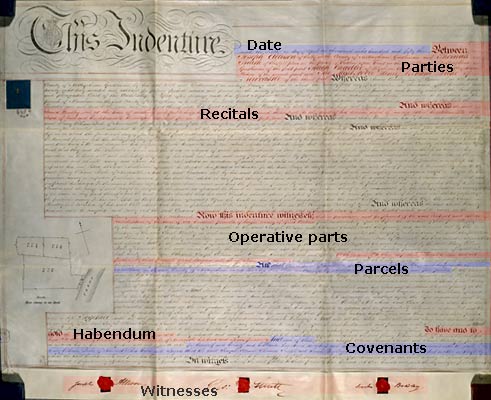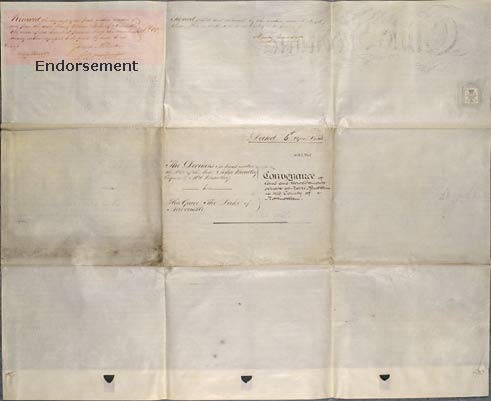Skills Required to Interpret Deeds
As previously noted, the format of deeds can be off-putting to researchers. However, whether in Latin or in English, whether early in date or later, most deeds are formulaic, and the information contained within them should be reasonably accessible.
When using deeds, it is easy to break them down into manageable chunks and then to deal with each chunk in turn. Most deeds from the sixteenth century onwards comprise of standard sections as follows:


Conveyance, North Muskham, 1853 (Ne D 2745)
Date
The date of execution of the deed is always listed at the beginning. This may be in the modern form we would recognise today (i.e. 29 June 1665), or it may be in the form of a 'regnal' date, indicating the year of the reign of a particular monarch (i.e. 29 June 17 Charles II). In addition, the actual day and month may sometimes be indicated by reference to a particular event or saint's day (i.e. the feast of St Peter and St Paul, 17 Charles II). A separate Research Guidance module is available to assist with dating documents.
Parties
These are simply the names of the individuals or organisations involved in the deed. They are listed in order, in the form 'First Party, Second Party, Third Party' and so on, and so are easily identifiable
Recitals
These provide a summary of the activity which has led up to the present deed, so, for example, they may recite details of a person's will, or of a previous conveyance or of a mortgage and so on. They will normally by introduced by the word 'whereas' and can be several in number. Normally the recitals are not essential to interpreting the current deed, and so do not always need to be looked at in detail
Operative Part(s) or 'Testatum'
This states the purpose of the deed, for example the effecting of a conveyance or a lease from one person to another. It can be identified by the phrase '(Now this indenture) witnesseth' or 'further witnesseth' and will normally include a 'consideration' (e.g. amount of purchase money, amount of rent) or other motive for the transaction (e.g. 'natural love and affection' shown by one relative to another)
Parcels
These provide a description (often detailed) of the property which is subject of the deed and can usually be identified by the words 'all that'
Habendum
This word comes from the Latin phrase 'Habendum et Tenendum', that is 'to have and to hold' and this section defines the terms of the estate. Therefore, freehold property may be conveyed forever, whereas leasehold property may be conveyed for a term of years
Covenants, Conditions and Provisos
These record details of agreements made between the parties which affect the property and transaction. For example, one party may promise to produce the deeds to the property as proof of title, may promise not to use land for a particular purpose, may promise not to sub-let a property and so on
Witnesses
Each deed will normally contain a list (and often signatures) of people who are acting as a witness to the transaction. Normally these will be the parties to the deed itself, but sometimes, particularly with earlier deeds, independent witnesses are listed. Each witness will normally make a seal
Endorsements
Literally things endorsed (or written) on the reverse of a deed. This could be a subsequent sale or agreement, a record of the receipt of purchase money, a record of the delivery of possession and so on
Next page: Some Resources to Aid the Understanding and Interpretation of Deeds